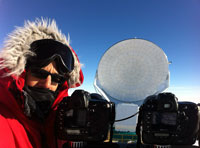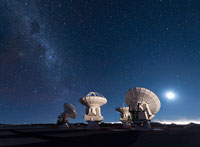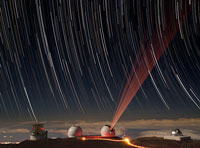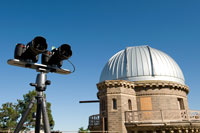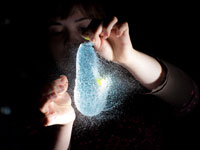Photography
I started experimenting with photography and darkroom processing during my early teenage years. I would photograph the Moon and planets as well as sunrise and sunsets with my Nikon EM. Several decades and Nikon camera bodies later I continue to photograph the sky as well as experiment with different photographic techniques such as time-lapse, infrared, high-speed flash, and fisheye photography for full-dome projection. My photographs and time-lapse sequences are featured in some of my films as well as in some Adler Planetarium productions (both fiull-dome and 3D shows). They have also been featured on CNN as well as on many productions by the BBC, the National Geographic, and Discovery Channels.
I hope my photographs make people want to learn about what they see in them. It could be Prague or the Milky Way. I am happy as long as the images inspire people to learn about something new. You can view my photographs by SUBJECT or by LATEST UPLOADS to Flickr.
Projects
Observatories Around the World
The first astronomical observatory I photographed was the Arecibo Observatory in Puerto Rico. I photographed it several times during my years there as an undergraduate and graduate student in the 90s. In 2008 I started systematically photographing the most important observatories around the world such as the Mauna Kea Observatories in Hawaii and Cerro Tololo Inter-American Observatory in Chile. To date I have visited almost 30 sites in five continents.
In August 2009, as a result of my growing reputation as an "observatories" photographer, the European Southern Observatory (ESO) invited me to photograph their telescopes on Cerro Paranal, Chile. This successful commission prompted similar requests from the University of Chicago to photograph observatories in California and Chile, and additional
requests by ESO. The latter named me an ESO Photo Ambassador in August 2010 in recognition of the “astonishing [captured] views of ESO sites and the Chilean skies”. In November 2011 I spent nine days
in Antarctica, including five days at the South Pole, photographing the South Pole Telescope for the University of Chicago — my most challenging photo assignment to date.
Below is my Observatories Flickr set (iPhone and iPad users should use link instead) and a table listing the sites visited and the telescopes photographed so far. Observatories visited in the 90s were photograped with Nikon film cameras and those images have not been scanned yet. Images from some observatories photographed as recent as a few years ago remained unprocessed, hence the lack of links to those subsets.
| Observatories | Telescopes | Location | |
|---|---|---|---|
| 1 | Apache Point Observatory | SDSS | Sunspot, New Mexico |
| 2 | Arecibo Observatory | Arecibo Telescope | Arecibo, Puerto Rico |
| 3 | CARMA | CARMA | Near Big Pine, California |
| 4 | Cerro Pachón | Gemini South, SOAR | Vicuña, Chile |
| 5 | Cerro Tololo Inter-American Observatory | 16-in, 0.9, 1.5-m telescopes, 1-m Yale, Curtis-Schmidt, Blanco Telescope, Lunar Scintillometer, PROMPT, GONG, 1.3-m, LCOGT | Vicuña, Chile |
| 6 | Fred Lawrence Whipple Observatory | VERITAS | Amado, Arizona |
| 7 | Jodrell Bank Observatory | Lovell Telescope, Mark II | Lower Withington, England |
| 8 | Kitt Peak National Observatory | Mayall 4-m Telescope, McMath–Pierce solar telescope, Arizona Radio Observatory | Tohono O'odham Nation, Arizona |
| 9 | LIGO | LIGO | Livingston, Louisiana |
| 10 | Llano de Chajnantor Observatory | ALMA, APEX | San Pedro de Atacama, Chile |
| 11 | Mauna Kea Observatories | Gemini North, Keck, Subaru, CFHT, IRTF, CSO, JCMT, SMA, UKIRT, UH88, VLBA | Mauna Kea, Hawaii |
| 12 | Mount Graham International Observatory | LBT, VATT | Safford, Arizona |
| 13 | National Solar Observatory | Dunn Solar Telescope | Sunspot, New Mexico |
| 14 | Observatorio Cancana | 14-in Meade Schmidt-Cassegrain | Cochiguaz, Chile |
| 15 | Owens Valley Radio Observatory | OVRO 40-m Telescope, Owens Valley Solar Array, VLBA | Big Pine, California |
| 16 | Paranal Observatory | VLT, VST, Vista | Near Antofagasta, Chile |
| 17 | Roque de los Muchachos Observatory | GTC, NOT, WHT, DOT, SST, JKT, INT, LT, Mercator Telescope, MAGIC | La Palma, Canary Islands |
| 18 | Royal Observatory, Greenwich | Refracting telescope | London, England |
| 19 | South African Astronomical Observatory | McClean Telescope | Cape Town, South Africa |
| 20 | South African Astronomical Observatory | SALT, 0.5-m Telescope, 1.9-m (Radcliffe) Reflector, 0.75-m Reflector | Sutherland, South Africa |
| 21 | South Pole | SPT, Keck Array | South Pole, Antarctica |
| 22 | Steward Observatory | UA Campus Observatory | Tucson, Arizona |
| 23 | U of Valencia Astronomical Observatory | 50-cm Planewave | Aras de los Olmos, Spain |
| 24 | Very Large Array | VLA, VLBA (Pie Town) | Plains of San Agustin, New Mexico |
| 25 | Yerkes Observatory | 40-in Refractor | Williams Bay, Wisconsin |
| Other sites | |||
| 26 | Sanford Underground Research Laboratory | Large Underground Xenon Detector (LUX) | Lead, South Dakota |
| 27 | Steward Observatory Mirror Lab | At the University of Arizona | Tucson, Arizona |
| 28 | Chichén Itzá | El Caracol Observatory | Yucatán, Mexico |
| 29 | Stonehenge | Ring of standing stones | Wiltshire, England |
| 30 | Newgrange | Circular mound with stone passageway | County Meath, Ireland |
Workshops
Introduction to Time-lapse Photography
I shot my first time-lapse sequence on Mars Hill in front the Parthenon in Athens in 2007. One year later I was enhancing those techniques by shooting in stereo (3D) for a film I was producing for the Adler Planetarium. Since then I have made six films that have benefit from shooting events that occur too slowly for the human brain to perceive and compressing them in time (eg, the apparent motion of the night sky, cloud formation, plant growth). In 2011 I designed a course for Calumet Photo in Chicago in which taught how to take time-lapse sequences, how to process them, and how to edit them in a coherent piece of work. This workshop is coordinated by KV 265
Course Outline
Selection of equipment
- Camera, lenses, filters, tripods, intervalometers, rotary tables, power supplies, accesories
Planning your sequence
- Scouting locations
- Dtermining start/end times and duration of sequences
Camera settings
- Focus, aperture, exposure time, ISO, bracketing, interval, NR settings
Monitoring sequences
- Breaking sequences into multiple ones
Image processing
- Importing, cataloguing, and processing images in Adobe Lightroom
Making movie files
- Exporting from Lightroom Importing into Quicktime Pro
Video editing in Adobe After Effects
- Importing
- Zooming, panning, and rotating; use of effects
- Making transitions
- Use of sound files
- Exporting
Teaching Science and Art through Photography
Photography lies at the intersection of science and art since a camera can be an artist's tool as well as a scientist's imaging device. In this workshop we explore how photographic techniques such as time-lapse, high-speed flash, and infrared photography can be used to not only create artwork but to learn (and teach!) about science concepts such as electromagnetic processes (eg, emission, reflectivity) and perception of time. We also take a look at how the resulting photographs can be combined with music to make short films that bring science and art together. This workshop was first given to thirty teachers in Anchorage, Alaska in January 2012 and it is coordinated by KV 265.
Broadcast, Publications, and Exhibits
Some of my photographs have been published in magazines and science books, and shown in cities such as San Juan, Chicago, San Francisco, Belgrade, Piestany (Slovakia), and Paris. I have contributed animations and time-lapse sequences to documentaries produced for the History, Discovery, BBC, and National Geographic channels. Also, I have been a Photoshop Guru Award finalist twice for my photocomposite work.

